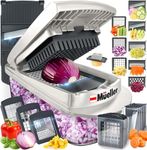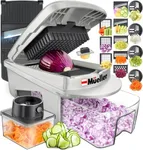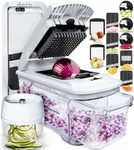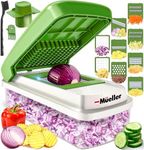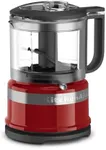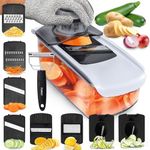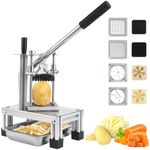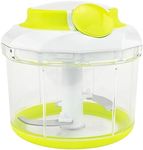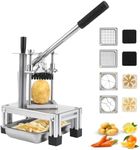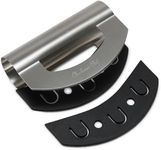Buying Guide for the Best Vegetable Choppers
Choosing the right vegetable chopper can make your food preparation faster, easier, and more enjoyable. When selecting a vegetable chopper, it's important to consider several key specifications to ensure you get the best fit for your needs. Understanding these specs will help you make an informed decision and find a chopper that suits your cooking style and preferences.Blade MaterialThe blade material is crucial because it determines the sharpness, durability, and ease of maintenance of the chopper. Common materials include stainless steel and carbon steel. Stainless steel blades are rust-resistant, easy to clean, and maintain their sharpness for a long time, making them ideal for regular use. Carbon steel blades are extremely sharp and durable but require more maintenance to prevent rust. If you cook frequently and need a reliable tool, stainless steel is a great choice. For those who prioritize sharpness and are willing to put in extra care, carbon steel might be the better option.
Chopping MechanismThe chopping mechanism refers to how the chopper cuts the vegetables. There are manual choppers, which require physical effort, and electric choppers, which operate with the push of a button. Manual choppers are typically more affordable, portable, and easy to clean, making them suitable for small kitchens or occasional use. Electric choppers are faster and require less effort, making them ideal for those who cook large quantities or have limited hand strength. Consider how often you cook and the volume of vegetables you need to chop to decide which mechanism suits you best.
CapacityCapacity refers to the amount of vegetables the chopper can hold and process at one time. Smaller choppers are compact and easy to store, making them perfect for small kitchens or single-person households. Larger choppers can handle more vegetables at once, which is useful for families or those who meal prep. Think about the typical amount of vegetables you chop and the available storage space in your kitchen to determine the right capacity for you.
Ease of CleaningEase of cleaning is an important factor because it affects how much time and effort you'll spend maintaining your chopper. Some choppers have dishwasher-safe parts, which can save you time and hassle. Others may require hand washing, which can be more time-consuming but might be necessary for certain materials. If you prefer convenience and have a dishwasher, look for models with dishwasher-safe components. If you don't mind hand washing or want to ensure the longevity of your chopper, consider models that are easy to disassemble and clean manually.
VersatilityVersatility refers to the range of functions the chopper can perform. Some choppers come with multiple blades and attachments, allowing you to slice, dice, julienne, and even spiralize vegetables. This can be very useful if you like to experiment with different recipes and need a tool that can handle various tasks. If you primarily need a chopper for basic tasks, a simpler model with fewer attachments might suffice. However, if you enjoy cooking a variety of dishes and want a multifunctional tool, look for a chopper with multiple blade options and attachments.
Safety FeaturesSafety features are important to prevent accidents and ensure a secure chopping experience. Look for choppers with non-slip bases, finger guards, and secure locking mechanisms. Non-slip bases keep the chopper stable during use, reducing the risk of slipping and injury. Finger guards protect your hands from the blades, and secure locking mechanisms ensure the chopper stays closed when not in use. If you have children or are concerned about safety, prioritize models with these features to ensure a safe and worry-free chopping experience.
